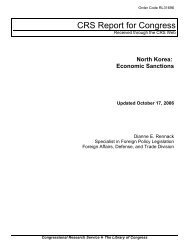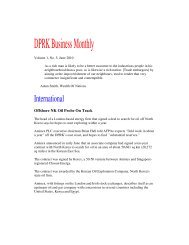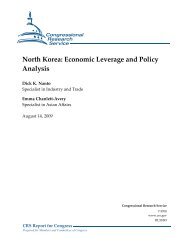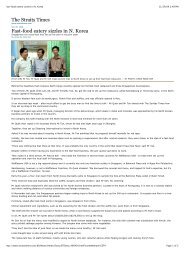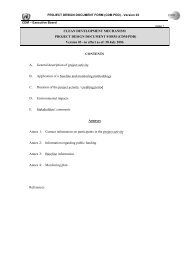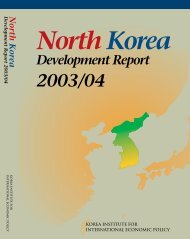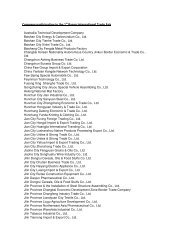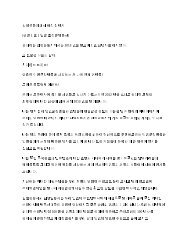- Page 1 and 2:
INSTITUTE FOR DEFENSE ANALYSES Nort
- Page 3:
INSTITUTE FOR DEFENSE ANALYSES IDA
- Page 7:
CONTENTS EXECUTIVE SUMMARY & INTROD
- Page 11 and 12:
To write accurately about North Kor
- Page 13:
technocrats, provincial and county
- Page 17:
PREFACE This paper will examine in
- Page 21:
ABBREVIATIONS AGI CCSKA COMSEC DoD
- Page 24 and 25:
information streams, and from him t
- Page 26 and 27:
within the hands of a few individua
- Page 28 and 29:
and whether or not he will embarras
- Page 30 and 31:
to the lowest-levels of the KPA. As
- Page 32 and 33: strengthening of all armed forces,
- Page 34 and 35: esearch institutes and “think tan
- Page 36 and 37: The primary missions of the Reconna
- Page 38 and 39: communication that generally fall o
- Page 40 and 41: of the State Security Department or
- Page 42 and 43: maintaining strict control over the
- Page 44 and 45: agencies in the ROK and Japan began
- Page 46 and 47: The Guard and Security Commands, wh
- Page 48 and 49: eports that are funneled up through
- Page 50 and 51: Complicating the entire “Kim-cent
- Page 52 and 53: Within the military, this dynamic c
- Page 54 and 55: him that all significant orders and
- Page 56 and 57: Until the 1990s, the electronic med
- Page 59: II. THE NORTH KOREAN LEADERSHIP: SY
- Page 62 and 63: TABLES 1. Key Family Members in the
- Page 64 and 65: The factional struggles in North Ko
- Page 67 and 68: A. INTRODUCTION By definition, a to
- Page 69 and 70: C. THE TECHNOLOGY OF POWER A Party
- Page 71 and 72: document control bureaus in each mi
- Page 73 and 74: Originally implemented in 1994 and
- Page 75 and 76: Table II-1. Key Family Members in t
- Page 77 and 78: of associates who trace their relat
- Page 79 and 80: September 9, 2003, showed a change
- Page 81: Chart II-2: Secretariat 5. Kye Ung-
- Page 85 and 86: Table II-6. Kim Chong-il’s Princi
- Page 87 and 88: Table II-7. Kim Chong-il’s Person
- Page 89 and 90: chance to unfold. In terms of syste
- Page 91 and 92: domestic policy arena, the split is
- Page 93 and 94: At the second echelon of power, Kim
- Page 95 and 96: D. FLOW OF INFORMATION George Kenna
- Page 97 and 98: about things that affect their care
- Page 99 and 100: (ID) and External Liaison (ELD) dep
- Page 101 and 102: For the rest of the North Korean le
- Page 103 and 104: the focus for not only a significan
- Page 105 and 106: At the 11 th Supreme People’s Ass
- Page 107 and 108: There is little doubt that one of t
- Page 109 and 110: decision-making process. Moreover,
- Page 111: III. THE WELL-INFORMED CADRE RALPH
- Page 115 and 116: EXECUTIVE SUMMARY DEFINITIONS AND A
- Page 117: greater access to first-hand inform
- Page 120 and 121: The first question addressed by thi
- Page 122 and 123: But this lack of enthusiasm is prob
- Page 124 and 125: as the 1950s. 16 The security organ
- Page 126 and 127: Another way to look at divisions wi
- Page 128 and 129: Because the Kim regime governs acco
- Page 130 and 131: guess is that anyone who rises in t
- Page 132 and 133:
But even though the media serve as
- Page 134 and 135:
Newspapers The DPRK’s premier new
- Page 136 and 137:
motivation in its readers through m
- Page 138 and 139:
Page 2: • Kim Jong-suk’s develo
- Page 140 and 141:
This selection of news items presen
- Page 142 and 143:
in the wake of the U.S. propaganda
- Page 144 and 145:
the general audience in a two-step
- Page 146 and 147:
also countries surrounding the Kore
- Page 148 and 149:
that the war in Iraq was “a test
- Page 150 and 151:
and transform us internally through
- Page 152 and 153:
eceived with little thought and has
- Page 154 and 155:
outside world than the ordinary wor
- Page 156 and 157:
cognitive dissonance, particular ca
- Page 159:
IV. INSIDE NORTH KOREA’S BLACK BO
- Page 163 and 164:
EXECUTIVE SUMMARY The North Korean
- Page 165 and 166:
A. BETTER, MERRIER, MORE HOPEFUL LI
- Page 167 and 168:
In contrast, the optimists believe
- Page 169 and 170:
to the throne. The State Council us
- Page 171 and 172:
1976-1977, 4 and in 1986-1987 (see
- Page 173 and 174:
Bulgarian Trade Unions, after which
- Page 175 and 176:
Second, the principal objective of
- Page 177 and 178:
southward expansion, and, last but
- Page 179 and 180:
controlling some of North Korea’s
- Page 181 and 182:
also against the second-tier family
- Page 183 and 184:
Kim Sung-ae, who is Kim Il Sung’s
- Page 185 and 186:
“National Security Establishment
- Page 187 and 188:
October 1980. Many of them (Yon Hyo
- Page 189 and 190:
severe draught in 1988 and the dram
- Page 192 and 193:
The advent of the “Songun Era”
- Page 194 and 195:
IV-30
- Page 196 and 197:
Bearing in mind Kim Jong Il’s rec
- Page 198 and 199:
Table IV-2. Composition of the Nort
- Page 200 and 201:
Cabinet Posts 10 th SPA 11 th SPA R
- Page 202 and 203:
Eastern Europe. That was reportedly
- Page 204 and 205:
Table IV-5. Leading Ideologues Insi
- Page 206 and 207:
Table IV-7. Regional Origins of Top
- Page 208 and 209:
“Foreign Wind” The “foreign w
- Page 210 and 211:
Table IV-10. Some of the Most Influ
- Page 212 and 213:
Table IV-11. The North-South “Han
- Page 214 and 215:
Song Sok Hwan Vice-Minister Cha Sun
- Page 216 and 217:
Table IV-13. Korean-American “Int
- Page 218 and 219:
content and government monitoring.
- Page 220 and 221:
Northern security, military, and pa
- Page 223:
APPENDIX B TONGIL STREET FREE MARKE
- Page 227:
V. REACHING INTO NORTH KOREA DAVID
- Page 231 and 232:
EXECUTIVE SUMMARY North Korea is no
- Page 233:
message right to Kim Jong-il, and m
- Page 236 and 237:
isk escape from the hermit kingdom.
- Page 238 and 239:
Society is divided into three broad
- Page 240 and 241:
contradictions.” 17 This makes se
- Page 242 and 243:
Internet is not specifically mentio
- Page 244 and 245:
led to a training program for young
- Page 246 and 247:
North Korea’s exports from legiti
- Page 248 and 249:
een the biggest buyers of ivory ove
- Page 250 and 251:
worker who travels throughout North
- Page 252 and 253:
If we want to reach into North Kore
- Page 254 and 255:
conversations with the correct mix
- Page 256 and 257:
Although the future of cellular tel
- Page 258 and 259:
There are a host of other things on
- Page 261 and 262:
Each of the five papers in this col
- Page 263 and 264:
promotions) and punishments (e.g.,
- Page 265 and 266:
although presumably all calls are m
- Page 267 and 268:
cultural rules.” Given the “str
- Page 269:
Speaking of Kim, whom does he consu
- Page 273:
Terms of Reference: North Korean Po
- Page 277 and 278:
Joseph S. Bermudez Jr. is an intern
- Page 279:
APPENDIX C ASIAN VIEWS OF NORTH KOR
- Page 282 and 283:
In any case, the reforms provide a
- Page 284 and 285:
View from Seoul The single most imp
- Page 287:
Form Approved REPORT DOCUMENTATION



